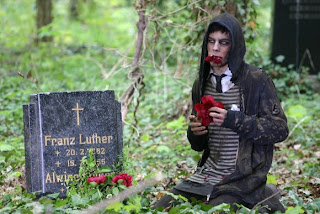*extra extra, newborn blog suffers as author struck with RSI...*
So, as one does, ihave been spending a little bit of time at MIFF over the weekend. I feel remarkably spoilt to be able to go to the cinema so often. The whole experience is definitely aided by dwelling near the city.
Thus far:
THE DRUMMER, Kenneth Bi, 2007
This definitely falls into the category of a beautiful film, with on the money pathos and a few quite transcendent scenes delivered by Bi.
The central character Sid, played by Jaycee Chan offspring of the preeminent Jackie, was the mobile pivot between the visual city/nature and thematic social/zen-individual dichotomy that is often typical of spiritual quest films. Here, Sid escapes from the troubles of having a gangster father, played by Tony Leung who was visually commanding though crafted unsympathetically in the script, and while in exile finds himself compelled to journey towards sounds in the mountains. Here he finds and joins a zen drumming group, their lessons and their drums helping him find his inner heart beat and self. A quintessential love plot was included without being a cloying addition to what is essentially is Sid's enlightened coming of age.
The visually commanding drumming sequences (which were placed somewhere between meditative or martial arts performance) would have been all the more compelling with a better sound mix. Both the soundtrack and the general sound quality were given a disappointing lack of emphasis considering the centrality of the transformative potentials of sound in the plot. Besides this small point, these dance like performances were the highlight of the film. They were as much about bodies as they were sound. Bi's interpretation of these bodies in movement and bodies as personality was right on the money.
REDACTED, Brian De Palma, 2007
I love De Palma, which is what attracted me to this film, unfortunately it was utterly problematic. While I was willing to allow that a film on the brutalities of the Iraq war wasn't likely to include a dose of his quintessential camping and excess, I don't feel like it offered any substantial substitute.
The film making felt uncomfortable and confused - which clearly was the point entirely of a film questioning the representational and narrative making processes surrounding the depiction of the Iraq conflict. But as an approach, I'm not sure that it worked. I felt antagonized as an spectator, rather than productively challenged, which made his polemic and its stylistic accompaniments difficult to swallow.
The proto-documentary style, which often slipped into artifice and tableau, made the 'realism' of a digital handheld camera seem just as constructed. Unfortunately it was also unwieldy to the point of vertiginous. The constant multiplication of narrators, occasional propaganda infusion, unfortunate actors, and random inclusion of war casualties in a tone of schlock-horror made it all the more noisy. Too much content, too much visual and thematic noise, meant that the politic was unheard, the atrocity from which it took its plot still ignored.
I also managed to catch HONEYDRIPPER, which I enjoyed alot and which you will surely hear my opinion of shortly :)


























